Photo: Earl Gardner
It’s a new season and, after years of 4-2-3-1 or die as the team’s tactical philosophy, the Philadelphia Union suddenly have a new formation.
In 2018, the Union performed in perfect mediocrity — right about where the pundits and fans figured them to be. The Union’s 4-2-3-1, now soccer’s most common and straightforward formation, was not really the problem, itself. The Union often played pretty, possession-based soccer last year and, were it not for career-poor years from David Accam and C.J. Sapong, could have earned a record high points haul. But it wasn’t meant to be.
The real culprit for fans’ teeth gnashing, though, was the Union’s refusal to shift any sort of tactics mid-game or even game-to-game. It was 4-2-3-1 or nothing. And now it’s dead. Shall we take a moment of silence?
Nah.
When the winds delivered new Union Sporting Director Ernst Tanner’s to Chester last fall, the immediate consensus was that Philadelphia were in store for a spiffy, new high-pressing formation. From the preseason lineup cards and Tanner’s own comments, everything points to the Union trotting out a 4-4-2 diamond — sometimes called a 4-3-1-2 — that intends to press up the field, defend narrowly, force turnovers, and counterattack.
Fans should be excited by the shift. Beyond the high-risk, high-reward nature of the formation itself, the diamond is a grit-and-hustle scheme that’s in-your-face for 90 minutes. It’s also fluid and malleable depending on opponents and personnel — so no more predictable winger and striker subs; you plug in a different player into a position and the formation shifts around their strengths.
So let’s dive into what exactly fans should expect from the Union’s tactical reset.
The Basics
The 4-4-2 diamond uses a traditional four-man backline and on paper looks a lot like old school American soccer’s most familiar 4-4-2 formation up the field. Two strikers, four midfielders, simple enough, right?
But that midfielder setup, in particular, is what truly sets the diamond apart. The formation eschews wingers (like, at all!) for four central midfielders — yes, that would be the diamond shape — providing a definite numerical advantage in the middle of the pitch versus most teams’s three central midfielders.
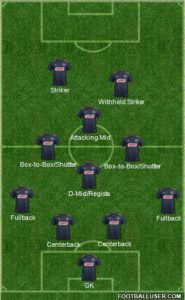
Also unlike a traditional 4-4-2, where there is no central attacking midfielder, the diamond employs a traditional No. 10 CAM at the top of the spear to steer possession on offense and cut off pockets of space on defense. Behind the 10, two box-to-box midfielders are tasked with, well, everything. The diamond is nothing if not a highly-demanding formation and these two central midfielder “shuttlers” are called upon to cover a whole lot of ground, from moving the ball between lines to defending all the way to the sideline. Paul Pogba excelled in this role during his time at Juventus, if that provides any type of indication the type of football intelligence, versatility, skill, and running required for the role.
Finally, the base of the midfield is held together by either
- a traditional defensive midfielder, also called the No. 6; or
- a deep-lying playmaker.
Teams often switch between the two depending on matchups or game states, and this personnel choice will be one of Union boss Jim Curtin’s biggest questions before every match.
With this very narrow and compact midfield comes a real lack of width, which is where most teams attempt to exploit the formation. The diamond attempts to counteract this weakness by relying on fullbacks to patrol huge swaths of real estate from endline to endline, providing width both in attack and defense.
Ernst Tanner put it succinctly to beat reporter Joe Tansey last week:
Tanner: “We are not using wingers anymore. We are calling a full back on the offensive side a wing back and on the defensive side an outside back.”
— Joe Tansey (@JTansey90) February 6, 2019
This is not only exhausting, but it can often leave the backline exposed. In response, if, say, a left back bombs up the field to join the attack in a diamond formation, the backline will keep its shape by either slipping the defensive midfielder into the hole between the centerbacks, or by shifting the whole backline left, with the right back dropping in line with the centerbacks — effectively morphing into a 3-5-2 in attack when the “wing backs” push high.
It’s a fascinating, fluid formation and it will be exciting to see how the Union roll it out in their opener versus Toronto FC in just a few short weeks.
In practice
In recent years, Liverpool under Brendan Rogers, Juventus under Massimiliano Allegri, and MLS Cup-winning Real Salt Lake under Jason Kreis all effectively used the diamond formation (one of these is not like the other).
It’s Juventus, though, that is the most interesting case study for our purposes. Here’s how the Bianconeri looked with Andrea Pirlo as a deep-lying playmaker (called a “regista”) at the base of the diamond against Real Madrid in the 2015 Champions League semifinal.
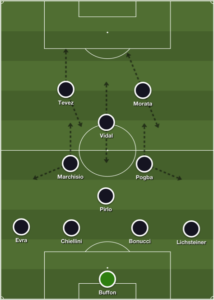
And alternatively, here’s how Juve looked with Claudio Marchisio as a more traditional No. 6 at the base of the diamond against Borussia Dortmund that same season.
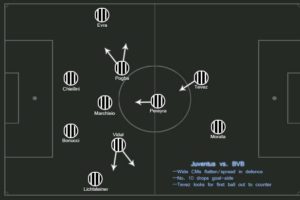
The difference between the two is the defensive responsibilities of the midfielders and forwards. With the, shall we say, defensive indifference of Pirlo, Juventus required the other three central midfielders to be responsible for the space in front of Pirlo and the entire second line of defense. With the more defensively-adept Marchisio sitting at No. 6, the attacking midfielder could keep the defensive shape at the top of the diamond, let the shuttlers cover wide, and allow the fullbacks push higher.
The diamond presses
I’ve covered quite a bit here with hardly touching on the role of the forwards in the 4-4-2 diamond. That’s crazy because the forward’s defensive responsibilities in a pressing diamond — like the Union intend to employ — are massive. Luckily, this is where the Union’s roster really works for the formation.
A successful defensive possession in a pressing diamond looks something like this (bold is the defending team in the diamond, italics are the offensive opponent):
- The two forwards press the opponents’ two centerbacks, the CAM covers the opposing defensive midfielder dropping in for the ball
- The centerback pushes the ball wide to a fullback
- The adjacent defending fullback pushes high to cut off wing support
- The center diamond rotates toward the fullback, cutting off easy central passes
- The fullback either tries a central pass that is collapsed on by the diamond midfield or hooves it long
The goal is to defend high up the field, push play wide and prevent any possession centrally, force turnovers, and quickly move up the field when the ball is won.
The forwards are critical to forcing pressure on the opposing backline and, if the ball is recovered, quickly finding channels upfield to attack in transition.
And offensively, it is all about transition. The diamond effectively sits eight field players behind the ball but thrives because the line of confrontation is so high. In a deep-sitting counterattack team, the entire team defends behind the ball, but everything is happening closer to the goal, creating more dangerous chances. Alternatively, the diamond attempts to mitigate risk by bringing that line higher up the pitch and moving quickly up the shortened field.
In a diamond, the attacks are simple, quick, and, if done right, deadly.
The Chester diamond
Here’s the fun part. Yes, the Union have some honestly-pretty-perfect strikers on the roster for a 4-4-2 diamond. The system’s forwards need to be tenacious and reflexive — working hard defensively and hungry to run into channels after turnovers. Wingers-turned-strikers Fafa Picault and David Accam, and newcomer Sergio Santos all fit this mold. C.J. Sapong and Corey Burke are similarly dogged defensively and, while lacking speed, are strong enough to add solid, linking hold-up play as second forwards.
Once the ball is won, it will be on Picault, Accam, and Santos to quickly turn upfield, run at players, and stretch the backtracking — and outnumbered — defense apart.
With buildup after turnovers occurring centrally, the midfield diamond will look for Mexican international Marco Fabian on the half-turn to push the ball upfield and find those streaking attackers on the counter. His resume and playing style indicate that he’s a pretty optimal talent for the position (yes, as long as he’s healthy, Dan Walsh).
The backline personnel should fit well too. While fans lamented the departure of local talent Keegan Rosenberry, the diamond’s demands on fullbacks might very well have spliced open his shortcomings with defensive positioning. Tanner certainly thinks steamrolling Cameroonian Olivier Mbaizo is up for the task with veteran Ray Gaddis backing him up. On the left side of defense, it will be an interesting season-long battle for playing time between Academy product Matt Real and new German signee Kai Wagner.
Midfield conundrums
The real questions are for the 2019 Union are with their central midfield role. It’s safe to say, though, that two positions are absolutely settled:
- “Biggest-ever-signing” Marco Fabian will slot in quite nicely into that No. 10, Central Attacking Midfield role, thank you very much
- Alejandro Bedoya might have found his perfect formation as a right-leaning, box-to-box shuttling midfielder; the U.S. international can cover a whole lot of ground, link play beautifully, and provide wide cover on both sides of the ball
That leaves the other shuttler role and the defensive midfielder very much up in the air. Luckily, who plays in one of these spots will dictate who plays in the other.
The first option is to follow Juventus’ regista model. Haris Medunjanin is made from regista mana from heaven. The Bosnian international possesses a puppet-master’s left foot that can kickstart a counterattack from anywhere on the field. If he plays at the base of the midfield, look for a more defensively-minded shuttler, likely either Derrick Jones or Warren Creavalle, to set up in line with Bedoya in central midfield. The perks of the regista set is that, while Medunjanin provides little defensive cover (like really little), the shuttlers can win the ball and quickly recycle the ball back to him and let his magical touch find streaking runners. On paper it would look something like this:
Alternatively, Curtin can opt to place a more traditional defensive midfielder in the No. 6 role — likely Jones or Creavalle again — and put a more possession-oriented player opposite Bedoya in the shuttler role. This would push buildup centrally through the numerically-advantaged midfield, instead of through long balls to streaking runners. Who that could be, however, would require another entire column, as few players on the roster seem to fit that mold. Another Union Academy product, Anthony Fontana, might be the team’s best bet at the moment in the box-to-box role adjacent to Bedoya.
Finally, Curtin recently hinted that the Chester diamond could employ two No. 10’s at the top of the diamond, rotating it into what would look like a 4-2-2-2 — a formation made popular by Tanner’s formula employer, Red Bull. This would allow the Union to use the strengths of their roster and put either Ilsinho or youngster Brenden Aaronson beside Marco Fabian, with Bedoya and a traditional defensive midfielder sitting behind them. Again, more flexibility and more options for Curtin to toy with.
Weaknesses
Without a major overhaul over the winter break, however, the Union roster is not yet totally suited for a diamond formation. There’s only one Bedoya on the roster and, while Creavalle has his defensive superlatives, no elite No.6 to be found. It might have been MLS 1.0, but those successful Real Salt Lake squads were critically dependent on Kyle Beckerman holding down the middle of the pitch to win the ball and catalyze counter attacks.
I see four main holes in the Union’s implementation of their new formation:
- Is Marco Fabian physically up for the 10-spot? It’s not just about on-the-ball magic, a No. 10 in a 4-4-2 diamond needs to be straight pugnacious and tireless without the ball. The bull-headed Chilean international Arturo Vidal held down this role for Juventus with aplomb. Can Marco Fabian do all the running necessary for a frenetic pressing style?
- Who is the second shuttler? This is a big one for me. Can Jones or Creavalle provide the needed link-up play if Medunjanin is sitting at the base of the diamond? Or if Jones or Creavalle are employed at the No. 6, who else besides Bedoya can be the box-to-box savant? Anthony Fontana might be the answer, but it’s hard to imagine Ilsinho or anyone else on the roster having the physical tools to take on this role. Unless, of course, Derrick Jones comes good and can take the next step with his passing and link-up play.
- What do we do with all these forwards? Now that there are no attacking wingers needed on the field, the Union, suddenly, have six actually-pretty-good forwards for just two spots. Depth is awesome, but it seems far-fetched to have C.J. Sapong, Cory Burke, and David Accam (not to mention Kacper Przybylko) all sitting on the bench. Tanner should be inclined to trade one of the team’s talented forwards for central midfield cover.
- Can Curtin take advantage of the flexibility? Part of what makes the diamond so cool is that it allows for some major tactical flexibility, both fluidly in-game and through tactical switches. Pull the CAM and add a winger, you have a nice, defensive 4-4-2; drop one of the full backs into a three-man backline and you have a 3-5-2; pull one of the forwards back for a whole Christmas tree full of fun in a 4-3-2-1; add a second CAM for a high-pressing 4-2-2-2. There are bonafide tactical wrinkles Curtin can finally apply versus opponents, but will he take advantage?
Breaking a diamond
I’d be remiss if I didn’t mention the vulnerabilities of the 4-4-2 diamond formation. With a totally new system, a high line, and a defense that, on average, isn’t old enough to order a beer , the Union are going to be tested often.
Look for opposing managers to push these tactics against the Union this year:
- Stretch them wide. Opponents will try to stretch the diamond apart by throwing numbers wide and, if the midfield diamond becomes disorganized, cutting through the middle of the field.
- Switch the ball. The diamond’s concentrated central midfield leaves it really, really exposed to big switches of play. When you have your entire midfield core within 20 yards of each other on one flank, there’s bound to be space across the field. A good team will switch the point of the attack quickly and break the defensive shape.
- Go deep. With the midfield all keyed in on the center of the pitch, long balls over the top can put skilled attackers in 1v1 situations close to goal.
- Match the midfield. How do you beat a four-man central midfield? Well, just add another midfielder yourself. New U.S. Men’s National Team manager Gregg Berguardioloa’s 4-3-3 that brings the right back centrally into midfield to morph into a 3-4-3 with the ball, can pull a diamond apart with the right ball movement.
Will it be enough?
Fans should seriously be enthused about the Union’s tactical shift. The 4-2-3-1 was pretty at times, but the Union simply didn’t have the horses or strike power to match up man-for-man with the likes of Atlanta United or NYCFC. The diamond provides tactical nuance that will help the Union go toe-to-toe with those clubs. It’s also an intense and frenetic formation that should appease the “Philly tough” sect. Finally, the fluidity and game-to-game shifts offered by the diamond might actually push Curtin and the Union to matchup-plan for opponents.
The diamond counteracts a lack of possession with quick, connected midfield transitions and a high, grizzled press. If teams beat the press with big switches, Philadelphia’s young backline will have to fend for themselves. Expect exciting, back-and-forth, and even high scoring contests all season under the 4-4-2 diamond. Will it lead to an actual playoff run? We’ll just have to wait and see.
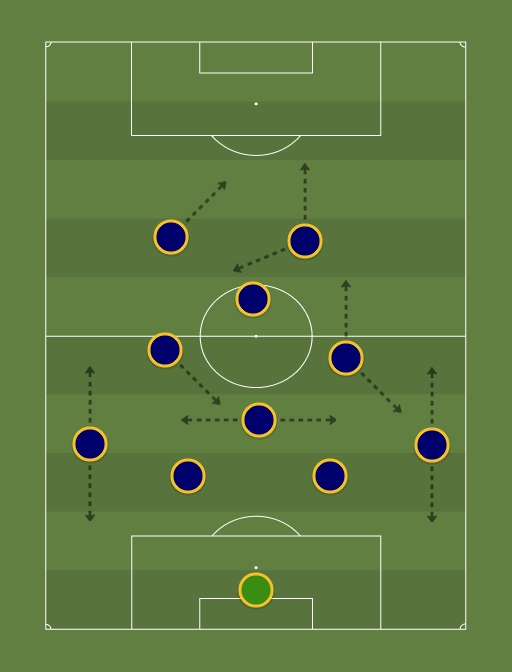


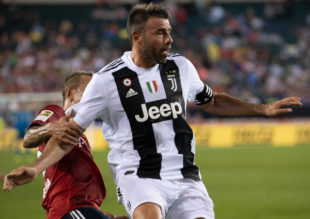

Great piece, Steven. It’s pretty exciting to see how different this team looks this season. Let’s hope it can look better on the results side, too.
–
A couple of good points you raise here:
–
1) The team definitely needs more midfield quality. At least one more solid midfielder if not two. Again, I suspect Tanner is looking hard at moving at least one of our forwards — Sapong and Burke most likely — to fund another midfielder.
–
2) The new style is going to put a lot of pressure on our centerbacks. Against good counter attacking teams that will turn the ball over on you while your line is high, our young guys are going to have to be very good. It will be a big test. I think our guys are athletically up to the challenge. They’ll need to be smart and well-drilled, too.
“Aplomb” is a fancy word, Steve. Solid write-up. I can’t really add anything except emphasize the beliefs that neither Haris nor Fabian is up the physical task ahead of them. One has clearly demonstrated this in the past and the other, I believe, will be taken aback by the tenacity in MLS. I foresee a 4-2-2-2 given our lack of depth in the midfield overall. Our backline will again be quite vulnerable but last year should’ve emboldened the younglings and for that I am grateful. First preseason game stream should be…interesting.
I’m not sure that Fabian will be taken aback by MLS’s style of play. After all, he spent the better part of a decade playing in Liga MX, and observers have described his game as very physical. The bigger concern would be his injury history, which I’d put in a separate category.
I think you’re ignoring the fact many players have come into the league and been knocked off-kilter. Many MX fans think Fabian is coming here specifically for a party and a paycheck. Say what you want about his dedication and or abilities, a player doesn’t know what he’s getting into until he’s into it. That’s all I’m saying, Peter. I know his pedigree. I also know the “retirement league” belief prevails abroad even if the quality has long since surpassed that criticism.
Nice write-up Whistles. I’d love to see the U use your second example (Jones at 6, Fontana at the 8 with Bedoya). And Accam traded for someone to play that 8 with Bedoya would be great too.
Trading Accam makes no sense right now. He’s coming of an injury and cost a million to come here. Playing him and hoping he regains his form is the smarter option. Corey Booker would make more sense for a trade as he has more value to other teams with his cap friendly contract. Besides he’s about to turn 30 in April.
Corey Booker (D-NJ)?
Thought Burke was younger than that? Wikipedia says he just turned 27 in December. I say trade Sapong and his feet of stone. When he finally got his chance to win the gig, Burke looked like the best goal scorer we’ve had in years.
Are any notable teams in the world using this formation right NOW though? I noticed the examples you used were all in the past.
Place I’d look first is any team with Red Bulls in its title.
.
Next the Bundesliga.
.
you catch my drift I am sure 😉
Tottenham has played a good bit of 4-4-2 diamond this year. And without a true #6.
Harry Winks, English regista. COYS! 🙂
It’s definitely seen it’s popularity fluctuate recently with the 4-4-3, 3-4-3, and 3-5-2 coming into their own with a lot of wide play. However, it was Zidane’s go-to formation for most of his tenure at Real Madrid. Good piece on that here: https://www.coachesvoice.com/tactical-analysis-real-madrid-3-psg-1/
I wan the 4-4-3 for the Union, but have a feeling the other team and ref’s might object to the man advantage. 🙂
Here is some info on 4-4-2 in England from a match preview.
http://blog.twelve.football/2018/08/30/watford-vs-tottenham-hotspur-preview-4-4-2/
There are other articles there as well.
Awesome piece Steven! I thoroughly enjoyed it.
.
This formation seems to require a lot of running from the midfield, which, as I am fond of pointing out, are mostly in or around their thirties. The need for squad rotation will be even more important than in the past. Will Curtin actually do it this year, or will there be another swoon 3/4’s of the way into the season. Hopefully Ernst brings in more reinforcements someway, somehow.
1. Well done, Steven! Enjoyable, clear.
.
2. Sunday, on YSC’s turf against NPSL side FC Motown (Morristown, NJ) Bethlehem played in the shape of the last diagram Steven gives above. Coach Burke had the forward tier of the midfielders a bit Wider than in Steven’s graphic, with one or both strikers dropping back into the empty space at the apex of the triangle normall occupied by a #10.
.
Rotate the diamond to a cube, conceptually, and turn the cube into a symmetrical quadrilateral with the two top vertices wider than the bottom one’s. Trapezoid, maybe? Plane Geometry was easily 55 years ago, sorry.
Really good write up, although I think Fontana does not get enough credit as a player who could easily step up and become a Bedoya like player at one of the midfield positions. I also think we could easily slide Elliot up to the CDM role which would really allow our outside backs to get up the field while still having cover. That said, I think I’d rather bring in another CB depth player than a CM player (unless the CM is a no doubt starter). We let the young CBs grow last year, lets give the young midfielders a chance this year.
I’ve been guessing at, and mentioning on these boards, a 4-2-2-2 since Santos and the first mention of “more transition” and “two forwards”. Most of it was given the forwards/wingers on the roster: Have to assume Santos is a starter given the investment, suspected that one of CJ/Burke is the other starter for a physical presence, and Fafa was great on the left last year, and historically, Accam has been good on the left with the Fire.
.
Also given Tanner’s RB connection, what came to mind was something like this:
https://spielverlagerung.com/2017/01/02/beyond-the-business-model-rb-leipzigs-football-philosophy/
.
.
I’m really interested to see what they are thinking personnel-wise and if they adjust throughout games and over the season.
Great article!
If the U can pull off the Juve model with Haris as Pirlo, that would be quite something! Not sure if our D can hold up with him there, but if it can, it will make for an exciting season!
Willingness to do it aside, does Accam have the skill set to be another #8 if Jones plays #6? I haven’t seen Accam play enough to know, but I am pretty sure that Sapong doesn’t have the requisite passing ability.
1) When I read about this formation, the people who seem to be the most strained are the fullbacks! They have to cover the entire longitudinal outside stripe of the pitch the whole match. That is seriously demanding. I cannot see Gaddis getting up into the offensive end enough for this. I hope Mbaizo and one of the other youngsters are up to the task. If not, we may need those “shuttlers” to get into the corners on offense. Bedoya certainly does that.
–
2) I think if we put Medunjanin at the back point of that diamond, we will get killed on D. He just does not provide enough cover for 2 young (no matter how excellent) centerbacks who may not be able to count on terrific support from their wingbacks (see point #1). I think we have to hand the keys to Jones and let him drive the D. And if he can’t do it, then it’s time the flex the formation — maybe try the 4-2-2-2 that so many of us were desperate for them to try last year anyway.
Great article and leaves me panting for the start of season 10. The one mystery that it does not really answer is the replacement of Rosenberry with Gaddis. Rosenberry was our very best attacking fullback. Last year he joined the attack, overlapping with Illsinio or cutting in to the top of the box on numerous occasions. Really he often played as a wingback even with our stilted formation and philosophy. How is Gaddis an improvement for our new look? As the longest serving team member we have years of watching Ray play hard and defend pretty well as long as he stuck closely to the back line. However, can anyone dispute that he has No ability to carry the ball or shoot it or take on an defender? I just don’t get it and have to assume that there was a ‘locker room’ reason behind Rosenberrys departure.
The issue with Rosenberry was never his offense, it was his positional defense. He was frequently caught in space in ways that made his role in this pressing system untenable. Ray is there because he’s Fabi or Chambers now: an older guy who can be the glue for the younger guys, who will bust his butt when he plays, but isn’t trying to make a European move anymore.
I suspect the Union will play the diamond more like a 4312 with the left and right mids tight with Haris on defense so he is not left on an island (unlike how the 41212 defends).
I can’t see them doing a typical 4222 since most teams defens in 442 with the wingers slotting inside on attack and press – Union don’t have the players to play like that. Now if they were to defend in a 4222 – that would be some fun fantasy video game tactics I’d love to see.
Just watch Athletico Madrid to see what it looks like……..
Big time ATTABOY to Steve for the spectacular analysis… well done, extremely informative